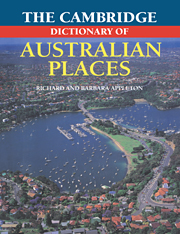K
Published online by Cambridge University Press: 05 March 2012
Summary
KADINA, SA (kă-dee-nă), 33 58S 137 43E (map 9), a town (pop. 3263) in the district council area of northern yorke peninsula, of which it is the administrative centre. It stands on what was formerly Ngadjuri Aboriginal land and its name comes from an Aboriginal term, caddy-yeena, meaning ‘plain of lizards’. Kadina was established in 1861 as a result of the discovery of copper there two years earlier. The copper mines, operated largely by miners from Corn-wall, formed the main industry of the area until their closure in 1923, and many of Kadina's buildings have distinctive Cornish features. The district is now largely given to the production of wheat, barley and wool.
KAHIBAH, NSW (kă-hye-bă), a southern New-castle suburb near charlestown (map 12) in the City of lake macquarie.
KAIRI, Qld (keer-eye), 17 13S 145 33E, a town-ship (pop. 221) in the Shire of atherton (map 5). Its name is derived from giri, a Yidiny Aboriginal term for incense wood.
KAKADU NATIONAL PARK, NT (kack-ă-doo), Australia's largest non-marine national park (1 755 300 ha), occupies the western section of arnhem land (map 3), including adjacent lowlands. Its name is derived from that of the Aboriginal inhabitants, the Gagudju, and the park is owned by Aborigines, who have leased it back to the Australian National Parks and Wildlife Service. Kakadu National Park has been included in the unesco World Heritage List.
- Type
- Chapter
- Information
- The Cambridge Dictionary of Australian Places , pp. 149 - 161Publisher: Cambridge University PressPrint publication year: 1993



